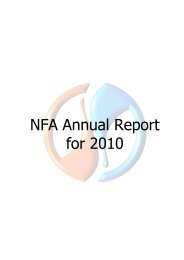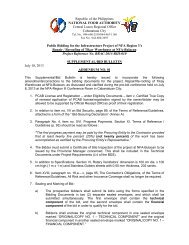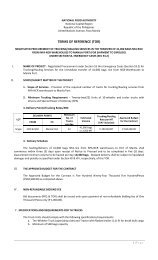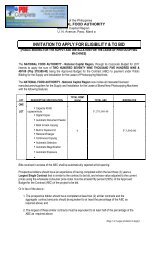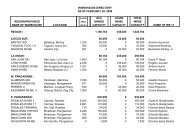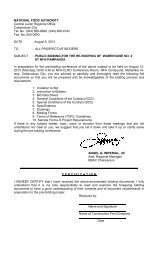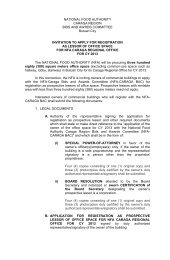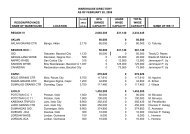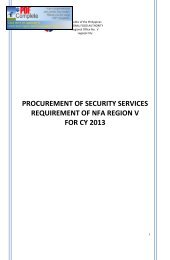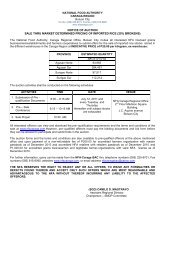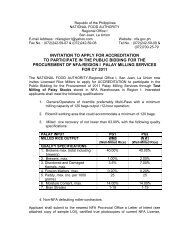Grains - 3rd Quarter : 2012 - NFA
Grains - 3rd Quarter : 2012 - NFA
Grains - 3rd Quarter : 2012 - NFA
Create successful ePaper yourself
Turn your PDF publications into a flip-book with our unique Google optimized e-Paper software.
1. Under the leadership of its first administrator,<br />
Jesus T. Tanchanco, <strong>NFA</strong> operated on seven major<br />
programs: procurement, distribution, production services,<br />
processing, infrastructure development, business<br />
promotion and regulation, as well as research and<br />
extension services.<br />
2. Embarked on massive facility build-up in 1975. Its<br />
food infrastructure program aimed to build adequate<br />
physical capability to effectively stabilize supply and prices<br />
of basic food, reduce postharvest losses and improve<br />
quality of food commodities. To this day, <strong>NFA</strong> maintains<br />
modern post-harvest and warehousing facilities, driers,<br />
rice mills, and others.<br />
3. Made first rice export to Indonesia on November<br />
28, 1977 with a shipment of 10,000 metric tons with 5,000<br />
MT exported two weeks later. Aside from Indonesia and<br />
Malaysia, Brazil also imported 32,030 MT of Philippine rice.<br />
The country was characterized by surplus not only in rice<br />
but in major staples as well in 1978 resulting in another<br />
rice delivery to Indonesia and Malaysia.<br />
4. NGA organized subsidiaries in 1978: NAPHIRE on<br />
May 24, QUEDAN on June 9, GRAINSCOR on October 3,<br />
and the Food Terminal, Inc. on March 27.<br />
5. Ventured into commercial food processing or<br />
commercial utilization of grains by-products. Established<br />
a pilot rice bran oil extraction plant at the Cabanatuan<br />
City grains complex. Large scale production began at the<br />
Southern Philippines <strong>Grains</strong> Complex in Tacurong, Sultan<br />
Kudarat. Also ventured into fabrication of bricks from palay<br />
husks, alcohol from grains, parboiled rice and the use of<br />
rice flour as wheat extender. Went into commercial<br />
processing of garlic and onions processing them into<br />
powder, flake and tablet forms and eyed for foreign<br />
markets.<br />
6. Established the Rice Parboiling Project – the pilot<br />
plant was donated by the Food and Agriculture<br />
Organization (FAO) and installed at the NGA Cabanatuan<br />
City grains complex.<br />
7. Witnessed the peak in export program in 1980<br />
with 230,624.95 metric tons exported to eight countries,<br />
among them Senegal, Mexico and Vietnam. A shipment<br />
of 83,000 MT was also made to Vietnam, Brazil and<br />
Indonesia as part of previous commitments. Export<br />
deliveries from 1977 to 1981 totalled 502,832 MT valued<br />
at $144.56M. Experimental shipments at minimal volumes<br />
of different food delicacies, fruits and vegetables were<br />
made to Singapore and Middle East.<br />
Special Feature<br />
25<br />
8. The first Kadiwa center rose on FTI grounds on April<br />
14, 1980. The agency authorized FTI to handle the direct<br />
supervision of the Kadiwa centers in Metro Manila. <strong>NFA</strong>produced<br />
rice bran oil was sold in the Kadiwa centers.<br />
9. On January 14, 1981, the NGA was reconstituted<br />
to <strong>NFA</strong> through Presidential Decree 1770 to cover other<br />
food commodities aside from rice and corn. This also meant<br />
additional powers: registration, licensing and supervision<br />
of entities engaged in wholesale, retail, processing,<br />
manufacturing, storage, transporting, packaging,<br />
importation, export of food commodities and other related<br />
activities. The reconstitution also authorized <strong>NFA</strong> to import<br />
and export food products of raw materials, equipment and<br />
facilities needed in the manufacture of food.<br />
10. Aside from cereals, <strong>NFA</strong> bought other food<br />
commodities, such as vegetables and meat products direct<br />
from producers and channeled to consumers at reduced<br />
prices through the Kadiwa centers. There were more than<br />
200 Kadiwa centers established nationwide located in the<br />
heart of thickly populated middle and low income<br />
communities.<br />
11. Marketing linkages with farmer organizations<br />
and cooperatives through various buying centers or<br />
stations.<br />
12. The <strong>NFA</strong>’s Corporate Farming Program allowed<br />
firms to engage in the production of food commodities<br />
aside from cereals. <strong>NFA</strong> embarked on direct farm<br />
production. Under the modular farming concept, farmers<br />
get technical assistance from <strong>NFA</strong> extension workers in the<br />
production of specific food products. The Corporate<br />
Farming Program was instrumental in boosting the country<br />
towards food sufficiency and surplus, and hastened the<br />
transfer of technology and farm management techniques<br />
to the countryside.<br />
13. Exhibition of KKK products at the Bloomingdale<br />
complex in New York and at the World Fair in Knoxville,<br />
Tennessee in 1982. The agency was tapped to become the<br />
lead agency in the marketing aspect of the Kilusang<br />
Kabuhayan at Kaunlaran.<br />
14. In 1984, the <strong>NFA</strong> became the government’s<br />
official wheat importer and distributor. This did not sit well<br />
with the private sector but was loaded by most sectors as<br />
rampant flour hoarding was averted.



